How Tweet It Is! I-MRSEC Workshop Helps Scientists Incorporate Twitter into Their Scientific Communication Repertoire
November 20, 2018
Are you passionate about communicating science, but a bit behind on the latest technology, like Twitter? Do you have an inkling what Twitter is and does, and are interested in finding out about how Twitter might be helpful to you as a scientist? Do you have a Twitter account, but haven’t quite gotten the hang of how to use it?
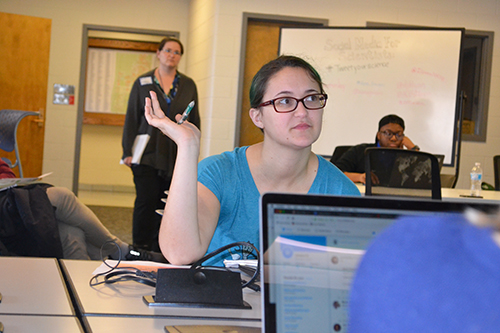
An Illinois PhD student, Kelsey Lowe, asks a question about Twitter during IMRSEC's recent “Social Media for Scientists: #Tweetyourscience" workshop.
A number of university folk who fit in one or more of the above categories showed up at the Physics Interaction Room on November 14th for a workshop: “Social Media for Scientists: #Tweetyourscience.” As the title implies, workshop participants hoped to find out more about how they might use social media—especially Twitter—to communicate science. Sponsored by I-MRSEC (Illinois Materials Research Science and Engineering Consortium), Beckman Institute 21st Century Scientists, and Illinois’ Graduate College, the workshop featured a talk by the Grad College’s Mike Firmand, a panel of researchers from Illinois’ science community who have a good Twitter following, plus some small groups based on participants’ level of Twitter expertise.
The workshop was part of I-MRSEC’s continuing efforts to underscore one of its core tenets: improving scientific communication. According to I-MRSEC PI Nadya Mason: “We decided that, as a community, we lacked communication skills at all levels, from students to faculty, both technically (giving clear talks to colleagues and peers), to non-technically (just telling the community what we are doing.)
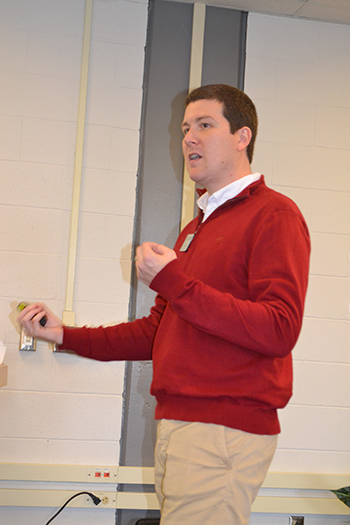
Mike Firmand, Assistant Director for Employer Outreach at the Graduate College, gives a talk about web presence and social media for professional success.
Helping to enlighten participants regarding the benefits (and pitfalls) of various online presence platforms, like websites and social media, was Mike Firmand, Assistant Director for Employer Outreach at the Grad College. In his talk, “Web Presence and Social Media for Professional Success,” Firmand indicated that the three main benefits of online communication were to 1) share research and ideas with new audiences; 2) gain support, guidance, and information; and 3) to find opportunities and potential collaborations.
Regarding websites, Firmand recommends using a simple landing page that’s easy to make and to maintain and which includes links to other places. He says static, multi-page sites can include more detail, and serve as more of an online resume or curriculum vitae. The drawback (or benefit!), of course, is that the owner often tends to ignore updating these for long periods of time.
According to Firmand, some of the benefits of Twitter are that it’s very popular with people in different fields, highly interactive, and a good source of information, relationships, and finding opportunities. Twitter’s main benefit? It’s very fast paced. Of course, he also claims that that one of the downsides to Twitter is…it’s very fast paced! Additional drawbacks are that it can be tough to navigate, it takes practice and, here’s the kicker: for those of us who find checking Facebook to be tedious and therefore only check it once a month, or who only update our personal website once every so often…he indicates that Twitter needs to be habitual!
Firmand also reviewed the pros and cons of several other social networks: LinkedIn, Github, Bitbucket, Behance, and Instagram. Regarding blogging, rather than launching a blog then fizzling out in a few short weeks, he suggests this endurance test: “Write a post a week and keep on file to see how the habit goes."
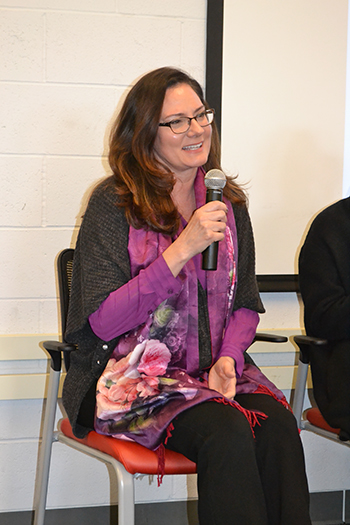
Integrative Biology Instructor Joanne Manaster shares an anecdote about learning to use Twitter with the audience.
Delighted to share why they had gotten involved with Twitter, as well as some Twitter tips and tricks, was a panel of Illinois researchers.
Regarding the science content the panelists share, and who is their audience, Integrative Biology Instructor Joanne Manaster says she has a wide array of followers from all different sciences, including science communicators, science writers, and just general population. (For the record, Manaster claims her handle, @sciencegoddess, was actually a nickname her students came up with, which kind of stuck). Regarding the science she shares, she says, “I just try to keep it to my areas that I find interesting, so there will be a lot of biology, and there will also be a lot of science books. So I sort of have a theme.”
In fact, she admits that if she tweets something like a music video that's not science related, she gets 0 responses. " People are not expecting that from me. So when you find your stride, people are going to follow you and look for that. And when they see something different, they think ‘Oh, that's a fluke!’ and just ignore it most of the time.”
Regarding the science she shares, Amy LaViers, (@alaviers), a Mechanical Science and Engineering Assistant Professor, says she doesn’t have many followers, “which I think gives me a lot of range in how I use my account,” she explains. On Twitter, she focuses on tweets and articles that appear in popular culture about robots, which is her area of research. “I tend to think of myself as a Twitter troll,” she divulges, “and when I see something that I think is misrepresenting, typically, the vast capacity of human beings, I do tend to tweet about that.” In fact, when someone from MIT recently tweeted that robots were better than humans, she disagreed and recommended that they reconsider their choice of words. The person took her advice and actually deleted the tweet!
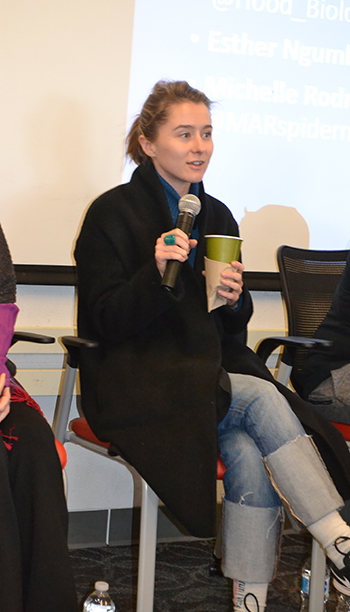
MechSE Assistant Professor Amy LaViers shares about her Twitter experience.
One audience question for the panel involved how to get a larger Twitter following: “What things get the most traction, and do you have any advice to make things go viral?”
Michelle Rodrigues, a Beckman Institute postdoc in the Department of Anthropology whose handle is @MARspidermonkey (she studies spider monkeys, obviously) advises Twitter newbies to make their tweets interesting visually.
“My trick is to try and use pictures and gifs whenever possible, because some people will like those and look at those, and then they'll actually pay attention to what you're tweeting. It helps at least with primate research. Cute monkeys go very far!” In addition to advising how to make tweets interesting, she recommends that if people totally ignore your tweet the first time, to keep on sharing it.
Confirming what Mike Firmand shared about social media providing opportunities and potential collaborations, Shay-Akil McLean, an Integrative Biology PhD student, says he’s gotten lots of opportunities through Twitter, from getting invited to be on panels to going to conferences: “It was because of the fact that I was discussing the research on Twitter, and that was one of the chief influences,” he admits.
McLean, who joined Twitter for general academic conversations, mostly shares work-related things, “as one way to communicate.” One thing he didn’t expect regarding Twitter is that so many people actually get on it and take it seriously. “Because I feel like I still don't take it seriously all that much,” he says.
McLean admits that he uses Twitter a lot, for just about everything. “When it comes to boundaries, or different topics, I'm pretty straightforward. With regards to whatever it is that I'm interested in, I will talk about.” He acknowledges that he doesn’t just tweet about work-related stuff. For instance, if he comes across something on Twitter about politics that’s directly related to his life, he’s not afraid to comment. “I feel at home doing this,” he admits. In fact, he feels so at home that he’s even shared his homework: “I do my homework on Twitter. I'm just live Tweeting my homework.”
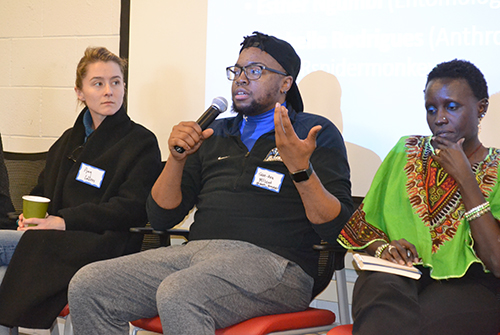
Shay-Akil McLean (center) an Integrative Biology PhD student, shares with the workshop participants about using Twitter.
In fact, he’s become quite well known through Twitter—not by name, of course; people know him by his handle: @Hood_Biologist.
“It's not a big deal,” he says, regarding his constant use of Twitter. “But then I go places. People will come up to me in public. I can't tell you how many bars or clubs I've been to, when people are like "Oh, my God, you're the biologist!" And they really don't know my name. Nobody ever knows my name. It's hilarious!”
Regarding using Twitter to communicate about science, he claims, “I did not know that it would have such a big influence in regards to industry.”
Entomology postdoc Esther Ngumbi confesses why she started using Twitter: “I was just trying to hustle my PhD!” But eventually she started gaining a following and realized that, as a Black woman scientist, Twitter was an excellent vehicle for her to not just communicate about science, but have a voice.
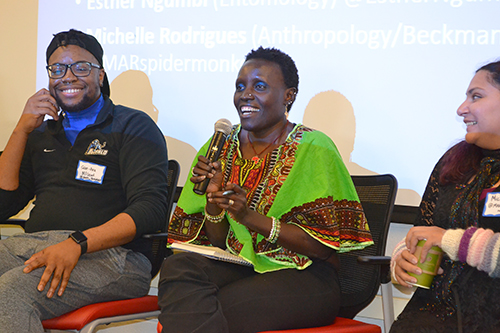
Esther Ngumbi shares with the workshop participants about her experience using Twitter.
“Then, I all of a sudden started growing, realized that I'm a minority and there's not many of us.” In fact, she believes her use of Twitter influenced other women to find their voice too. “There are women out there, women scientists who realized that, ‘I have a voice that I can use. I have so much information that I can share!’ So I started tweeting, and I started growing and having fun and just following the people who follow me.” She indicates that sharing her work via Twitter has been “opening so many other outlets. So I just use every opportunity that I can get.”
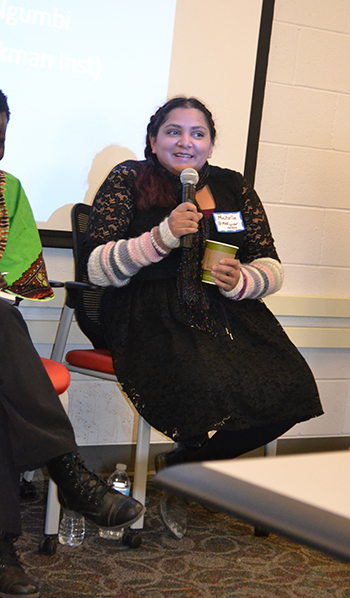
Michelle Rodrigues, a Beckman Institute postdoc in the Department of Anthropology, shares about using Twitter to communicate about her spidermonkey research.
Michelle Rodrigues (@MARspidermonkey) says she originally joined Twitter for professional reasons. And while she asserts that everyone has their own balance regarding “keeping it on message and super sciencey or more personal…But I like kind of having those melded together,” she says.
However, she wasn’t always that way. She says that at first, she thought she “had to stay super focused and on message.” However, she eventually got comfortable enough to start having fun with Twitter. While she doesn’t tweet about what she had for breakfast, she does joke around, and share personal things: “I will talk about things I'm interested in,” she maintains, “and a lot of times, talking about things you're interested in and your hobbies and random things you're excited about are what get non-scientists actually interacting with you and following and interested in the science stuff.”
Rodrigues believes one of the benefits of Twitter is that it shows people that you’re a real person, and not just a scientist. “There are also a lot of people talking on Twitter about the importance of showing that scientists are real people and not white men looking like Einstein or whatever. Sometimes that really does humanize who we are.”
Following the panel, participants broke out into groups for a time of application based on their level of Twitter expertise or area of interest. For example, “Twitter 101” was for folks who had never used Twitter before. Members of this group, say, might have been at the stage where they needed to create an account and figure out a good handle. The “Tweeting Science” group was for those with Twitter accounts who hadn't really figured out how to use them for scientific communication. The activity for that group involved practicing writing tweets about their research. Still another group, “Using Accessible Language in Your Tweets” was for those who wanted practice communicating with a more general audience. So that group focused more on the vocabulary that they're using and thinking of ways to make it more accessible. The final group, "Curating your following and feed” was about encouraging those who currently tweet to more accurately assess and meet the needs of those who follow their tweets.
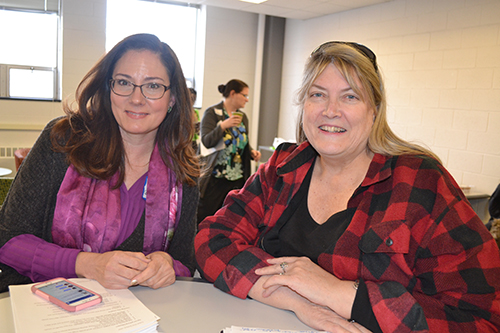
Joanne Manaster (left) and a workshop participant prepare to chat about "Curating your following and feed” during one of the workshop's breakout groups.
What motivated people to participate in the workshop? One participant, a PhD student from the Program for Ecology, Evolution, and Conservation Biology, Kelsey Lowe, believes having a social media presence is becoming important in order to grow one’s career. Lowe, who studies frogs, has an Instagram account which she uses to post pictures of her field work. “It's fun to take pictures,” she acknowledges, “and it's fun to share that, but apart from that, I'm not really sure how to navigate professionally, so that's why I came." Plus, "I'm not really sure what to post about!” she admits.
Part way through the workshop, Lowe had evidently heard enough. She was setting up a Twitter account during one of the breaks. Her goal? “I would like to be able to network better with colleagues and stay up to date with people I don't see very often, because I collaborate with people out of town. So it'd be nice to be able to stay connected with them. I know that they Tweet, and they have very active Twitter accounts.”
She cites another reason she wants to Twitter: she’s gone to conferences where she’s seen a hashtag for the conference posted. “So that would also be very helpful to be able to engage that way,” she admits.
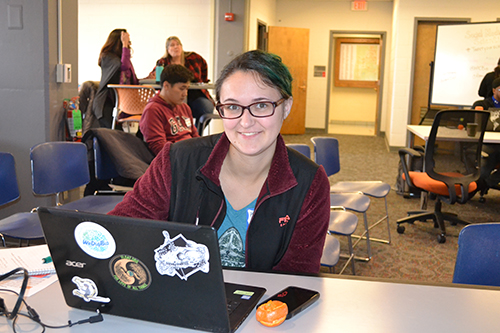
Kelsey Lowe, a PhD student from the Program for Ecology, Evolution, and Conservation Biology (PEEC), signs up for a Twitter account during a break in the workshop.
I-MRSEC PhD student, Kisung Kang, whose research involves simulations regarding materials with magnetic properties, especially antiferromagnetic materials, reports that he currently doesn’t use any social media, but he’s “interested” and “curious” as to whether it might help him to network in his science field in the future.
Story and photos by Elizabeth Innes, Communications Specialist, I-STEM Education Initiative.
- I-MRSEC’s Alda Scientific Communication Workshop Trains Scientists to Relate to Their Audience
- I-MRSEC: Creating a Multidsciplinary Materials Research Community
More: Externally Funded, I-MRSEC, MatSE, Science Centers, 2018
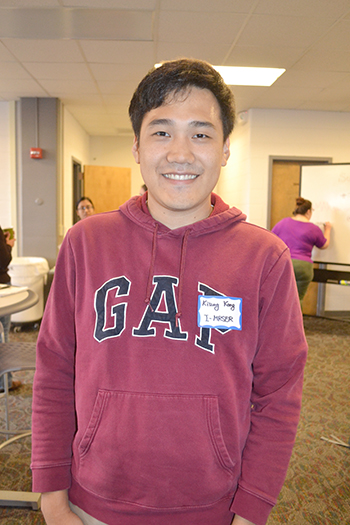
I-MRSEC PhD student, Kisung Kang.
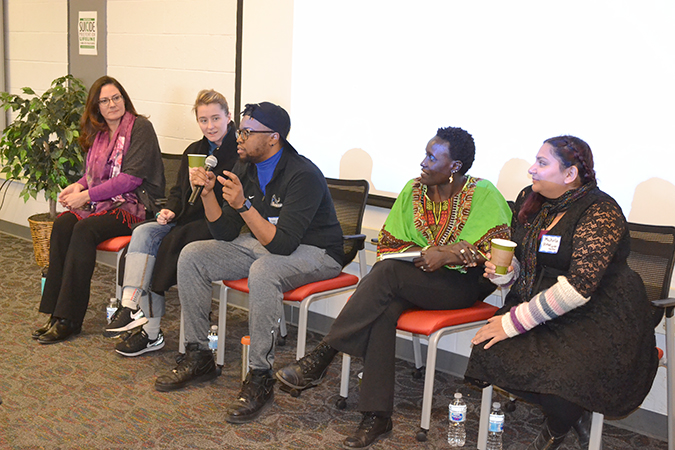
Left to right: Tweet-Savvy panelists at IMRSEC's recent Twitter Workshop: Joanne Manaster, Amy LaViers, Shay-Akil McLean, Esther Ngumbi, and Michelle Rodrigues.













.jpg)
















